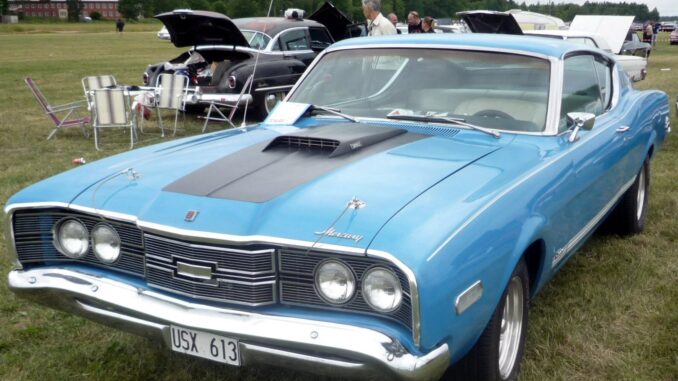
The Mercury Cyclone GT, introduced in 1968, is a quintessential example of American muscle cars that rose to prominence in the 1960s and 1970s. The Cyclone name itself first appeared in 1964 as an upgrade to the Mercury Comet, but it wasn’t until 1968 that the Cyclone GT truly emerged as a distinct model with its own identity.
The Cyclone GT was part of Mercury’s effort to capitalize on the growing popularity of performance-oriented vehicles, a trend driven by youthful consumers eager for speed and style.
Mercury, a division of Ford Motor Company, positioned the Cyclone GT as a sportier alternative to its Ford counterpart, the Fairlane. The Cyclone GT aimed to offer a blend of performance and luxury, appealing to those who desired a powerful car without sacrificing comfort and aesthetics. The 1968 model year marked a significant transformation for the Cyclone GT, with new styling and performance features that set it apart from previous iterations.
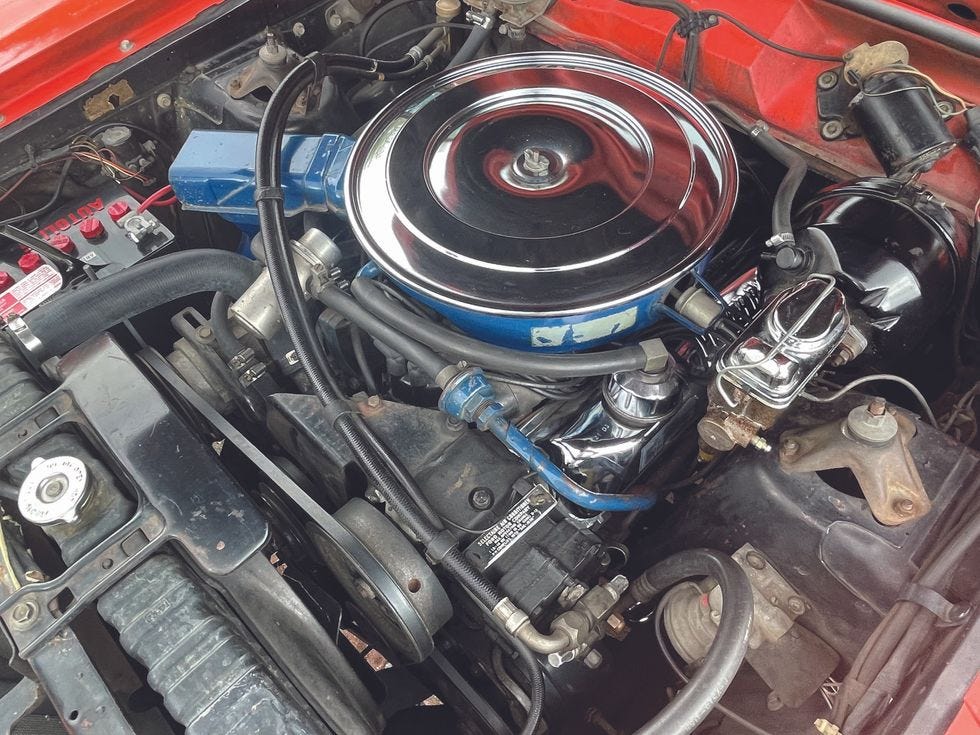
Power Enhancements and Engine Design
At the heart of the 1968 Mercury Cyclone GT was its engine, which was a crucial component of its performance appeal. The Cyclone GT was equipped with a 302 cubic inch (4.9 liters) V8 engine as standard, but several more powerful options were available for those seeking greater performance. The most notable of these was the 390 cubic inch (6.4 liters) V8 engine, capable of producing up to 325 horsepower. This engine featured a four-barrel carburetor and was mated to either a four-speed manual transmission or a three-speed automatic transmission, offering drivers flexibility in their driving experience.
For the true performance enthusiast, Mercury offered the Cyclone GT with a 428 cubic inch (7.0 liters) Cobra Jet V8 engine. This engine was a powerhouse, delivering 335 horsepower and 440 lb-ft of torque. The Cobra Jet engine was designed for high performance, featuring a higher compression ratio, larger carburetor, and a more aggressive camshaft. These enhancements allowed the Cyclone GT to achieve impressive acceleration and top speed, making it a formidable competitor in the muscle car arena.
Changes That Made It More Powerful
The 1968 Cyclone GT benefited from several engineering and design changes that contributed to its increased power and performance. The introduction of the Cobra Jet engine was one of the most significant upgrades, providing a substantial boost in horsepower and torque compared to previous models. This engine option transformed the Cyclone GT into a serious contender on the drag strip and the open road.
In addition to the powerful engine options, the Cyclone GT featured improvements in its suspension system, which enhanced handling and ride quality. The front suspension was equipped with coil springs and wishbones, while the rear utilized leaf springs and shock absorbers. These components worked together to provide a balanced and responsive driving experience, allowing drivers to fully exploit the car’s performance capabilities.
The 1968 model year also saw the introduction of a more aerodynamic body design, which reduced drag and improved overall efficiency. The new styling included a sleek, fastback roofline and a refined grille design, which not only enhanced the car’s appearance but also contributed to its performance.
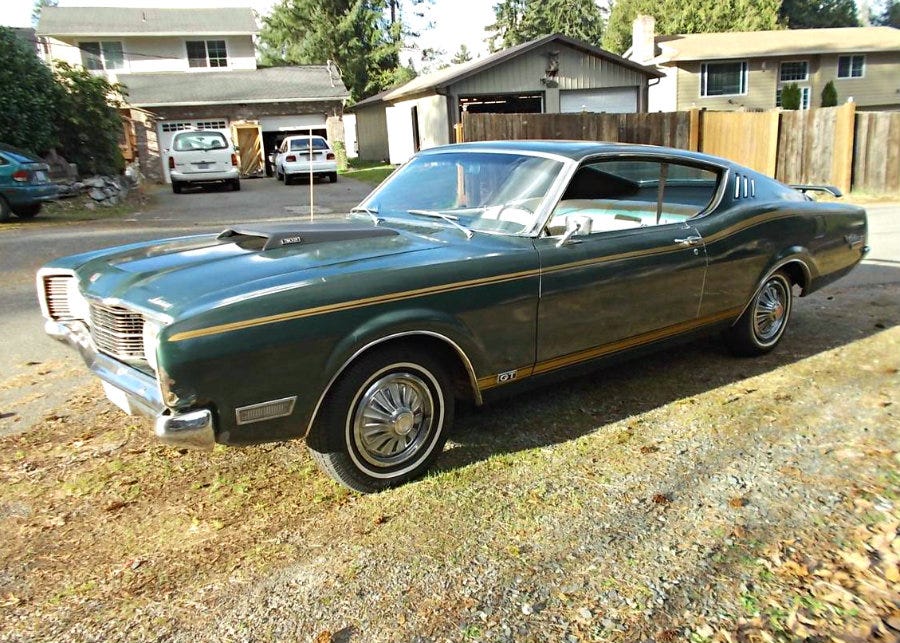
Safety Features
While performance was a primary focus for the 1968 Mercury Cyclone GT, safety was not overlooked. The car was equipped with several safety features that were advanced for its time. These included front disc brakes, which provided superior stopping power compared to the traditional drum brakes found on many other cars of the era. The Cyclone GT also featured a dual-circuit brake system, ensuring that if one circuit failed, the other would still function.
The interior of the Cyclone GT was designed with safety in mind as well. The car was equipped with seat belts for all passengers, a feature that was becoming more common in the late 1960s but was not yet standard across all vehicles. Additionally, the Cyclone GT featured a padded dashboard and energy-absorbing steering column, both of which were designed to reduce injury in the event of a collision.
Weight and Body Style
The 1968 Mercury Cyclone GT was built on a unibody platform, which contributed to its relatively lightweight construction. Weighing in at approximately 3,400 pounds, the Cyclone GT was lighter than many of its competitors, giving it an edge in terms of acceleration and handling. The unibody design also contributed to the car’s structural rigidity, improving overall safety and performance.
The body style of the 1968 Cyclone GT was a key factor in its appeal. The car featured a sleek, fastback design that was both stylish and functional. The fastback roofline improved aerodynamics, while the long hood and short deck gave the car a balanced and aggressive appearance. The Cyclone GT was available in both hardtop and convertible body styles, allowing buyers to choose the configuration that best suited their preferences.
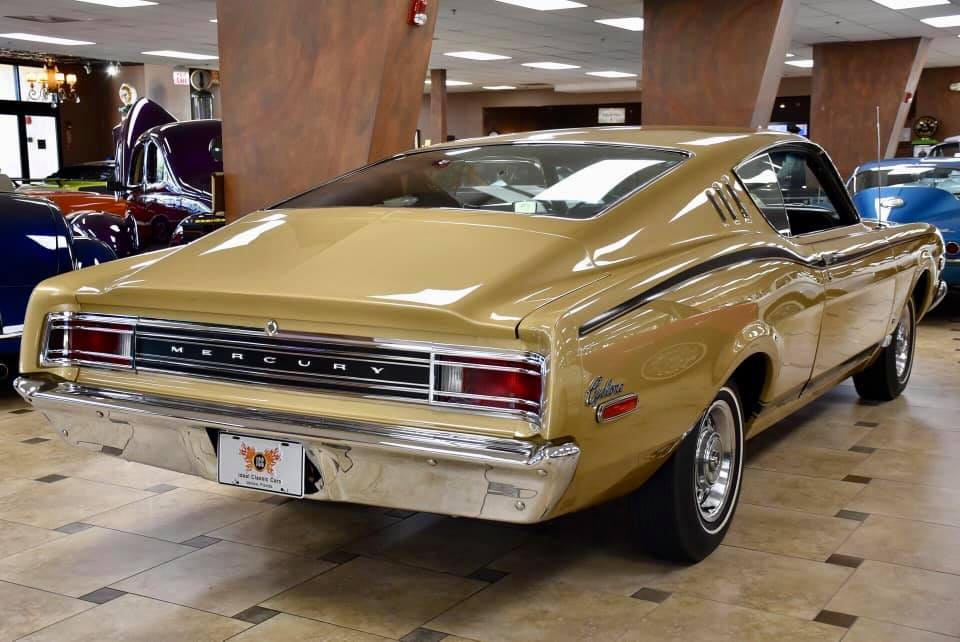
Unique Features
The 1968 Mercury Cyclone GT was distinguished by several unique features that set it apart from other muscle cars of its era. One of the most notable was the “Twin Scoop” hood, which not only added to the car’s aggressive appearance but also provided functional air intake to enhance engine performance. The hood scoops were a signature design element of the Cyclone GT and contributed to its distinctive look.
Another unique feature of the Cyclone GT was its sequential rear turn signals, a design borrowed from Mercury’s more luxurious models. This feature added a touch of sophistication to the car and was a subtle nod to the brand’s emphasis on combining performance with luxury.
The interior of the Cyclone GT was designed to provide both comfort and style. The car featured bucket seats, a center console, and a sporty dashboard layout with round gauges and a tachometer. These elements combined to create an inviting and driver-focused cockpit that enhanced the overall driving experience.
Pop Culture Uses
The Mercury Cyclone GT has made several appearances in popular culture, cementing its status as an iconic American muscle car. The car’s striking design and performance capabilities have made it a favorite among car enthusiasts and collectors, and it has been featured in various films, television shows, and music videos.
One notable appearance of the Cyclone GT was in the 1974 film Gone in 60 Seconds, where it was prominently featured alongside other classic cars. The movie showcased the car’s speed and agility, highlighting its performance credentials. The Cyclone GT has also been seen in television shows like CHiPs and The Dukes of Hazzard, further cementing its place in the American automotive landscape.

Other Unique Facts and Features
The 1968 Mercury Cyclone GT was not just a performance powerhouse; it also offered several unique features that contributed to its appeal. One such feature was the “High-Back” bucket seats, which provided improved support and comfort during spirited driving. These seats were designed to hold the driver and passengers securely in place, enhancing the overall driving experience.
The Cyclone GT was also available with a range of optional equipment, allowing buyers to customize their cars to suit their preferences. Options included a power-operated convertible top, air conditioning, and an AM/FM radio with a rear speaker. These features added a touch of luxury and convenience to the Cyclone GT, making it an attractive option for those seeking a well-rounded muscle car.
In addition to its performance and luxury features, the Cyclone GT was also known for its durability and reliability. The car’s robust construction and well-engineered components contributed to its reputation as a dependable vehicle, capable of handling both everyday driving and high-performance demands.
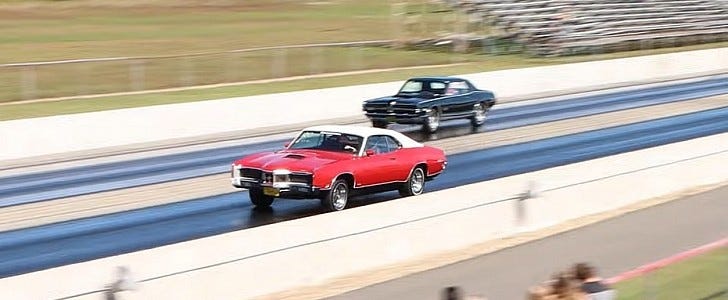
Conclusion
The 1968 Mercury Cyclone GT remains a classic example of American muscle car design and engineering. Its powerful engine options, stylish body design, and unique features combined to create a car that was both thrilling to drive and visually striking. The Cyclone GT’s blend of performance and luxury made it a standout in the competitive muscle car market of the late 1960s, and its enduring popularity among collectors and enthusiasts is a testament to its enduring appeal.
Today, the 1968 Mercury Cyclone GT is celebrated as an iconic representation of the muscle car era. Its appearances in popular culture, along with its distinctive design and performance capabilities, have ensured its place in the annals of automotive history. Whether on the road or in a car show, the Cyclone GT continues to captivate audiences with its blend of power, style, and sophistication.
STREAMING DEAL FROM PARAMOUNT +

For a limited time, Paramount+ annual plans start at $2.50/mo. for 12 months using promo code FALL50. Stream the NFL on CBS live and more! Don’t drop the ball—this special offer ends September 23. Billed annually. Terms and conditions apply.
Stream the NFL on CBS and watch your local game live every week! Plus, catch featured national games including the Thanksgiving matchup and the postseason.
Don’t miss another snap. Take advantage of this limited time offer and stream the NFL on CBS live on Paramount+. Redeem now!
CLICK HERE FOR LIMITED TIME OFFER
ACT NOW! For a limited time, Paramount+ annual plans start at $2.50/mo. for 12 months using promo code FALL50.
Everyday your story is being told by someone. Who is telling your story? Who are you telling your story to?
Email your sustainable story ideas, professional press releases or petro-powered podcast submissions to thecontentcreationstudios(AT)gmail(DOT)com.
#thecrudelife promotes a culture of inclusion and respect through interviews, content creation, live events and partnerships that educate, enrich, and empower people to create a positive social environment for all, regardless of age, race, religion, sexual orientation, or physical or intellectual ability.
MORE FROM THE CRUDE LIFE
- Please click that ♡ button, share, and subscribe.
- Please share the links on social media.
- Thank you thank you thank you for your engagement and support.
If you have a news tip, press release, guest suggestion or other content concepts, please email thecontentcreationstudios(AT)gmail(DOT)com
This post was brought to you in part by one of The Crude Life’s fantastic sponsors, please consider supporting their services or learning more about their organization by clicking on the banner below.

Witting Partners
Witting Partners helps energy industry leaders achieve and sustain peak performance by combining an unmatched blend of oil & gas experience, insight, and results with the power of leadership coaching, workshops, and keynotes so that you and your stakeholders don’t un-wittingly damage your odds of achieving long-term success.
If you want to produce 𝑺𝑼𝑺𝑻𝑨𝑰𝑵𝑨𝑩𝑳𝑬 results, then turn to a resource with 15+ years of proven success stretching from the Gulf of Mexico to Appalachia, from service company to operator, and from drilling rig to downtown boardroom.
To learn more, visit Witting Partners’ website or follow on LinkedIn.

